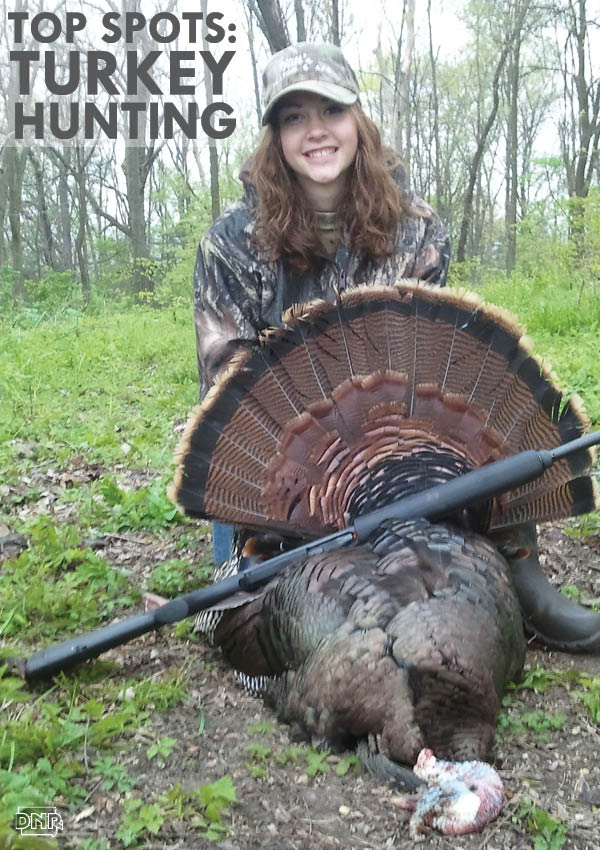 While we’re not about to give away anybody’s prized hunting spot, there are areas better than others when it comes to turkey hunting. And fall hunting’s a totally different game than spring turkey hunting. Fall regulations allow for the take of any sex or age of a wild turkey, one per turkey license, but mature males are more difficult to hunt in the fall. Here are some tips to find a great place to hunt:
While we’re not about to give away anybody’s prized hunting spot, there are areas better than others when it comes to turkey hunting. And fall hunting’s a totally different game than spring turkey hunting. Fall regulations allow for the take of any sex or age of a wild turkey, one per turkey license, but mature males are more difficult to hunt in the fall. Here are some tips to find a great place to hunt:
You can stay close to home. Wild turkeys are found in all 99 Iowa counties and can be found in deep forest to riparian areas along streams (tip: turkeys do need trees to roost in at night). If you want to hunt private land, be sure to ask the landowner’s permission first. If you’re looking for a spot on public land, try the Iowa Hunter’s Atlas to find a spot not too far from home.
Or you can venture out. A trip to western Iowa’s Loess Hills or northeast Iowa’s Yellow River State Forest can provide a unique hunting experience. Southeast Iowa is always a perennial favorite too, as about two-thirds of Iowa’s timber is located in the eastern third of the state. Beware, that unlike Iowa’s spring season, fall hunters must choose a zone, and licenses are limited. Turkey season dates and zone map
Find the flock. Typical fall hunting involves locating groups of turkeys that will include hens and young of the year. The hunter will break up the flocks and call them back together. Adult males will generally not be found with the hen groups and will not readily be called into a hunter’s position. Bowhunting provides some great opportunities to harvest a turkey either from a ground blind or from a tree stand. If you’re bowhunting, look for good feeding areas, like near good acorn producing trees or field edges with lots of grasshoppers. Seeing turkeys while pursuing deer with bow is not uncommon. With some overlap in the seasons, deer bowhunters may want to make sure you have your turkey tag in case the opportunity arises.
Avoid open areas. The more open the country, the easier it is for a turkey to see an approaching hunter (and remember, they can see better than humans can). If they all exit an area together, it is nearly impossible to call one to you. Blend in to the background if you want to see more birds. You don’t need a big property for a successful hunt, as many turkeys can be found on small 40-acre parcels.
Look for turkey paradise. The ultimate land mix to find turkey includes about a quarter timber, a quarter agricultural crop, a quarter of grasslands and the last quarter in mixed shrubs. This mix gives turkeys everything they need in a relatively small area.
It’s all in the timing. Unlike the spring, where we may try to get out in the woods for the first gobble, we can take advantage of the turkeys desire to feed throughout the day. Fall turkey hunting is an underused activity. Hunters can expect little pressure from other hunters in most areas. Also plan ahead for what the property will look like when you’re hunting, noting any changes in the distance hunters can see. A turkey’s diet will change with the weather and food availability. Cool nights will mean less insect activity. Shorter days will mean nuts will soon be falling to the ground. Pay attention to the fall harvest activities as well. This can have some bearing on turkey movements.
Call me maybe. A common mistake in the spring is calling too much. However, in the fall, desperate calling can sometimes send turkeys into a frenzy trying to locate a lost member of the flock. Remember, you only want to tease the bird. Once you call, just stay put, because that turkey knows where you are. In the fall, calling usually consists of clucks and kee kee run calls. This is the call of immature birds.
Bring the dog. Dogs can be used for fall turkey hunting, usually to help find and break up flocks. Some Iowa hunters have found success by locating birds over pointing dogs.
Turkey season dates and zone map
For more turkey tips, tricks and factoids, follow us on Twitter or check out our Iowa Hunting and Iowa Wildlife boards on Pinterest.